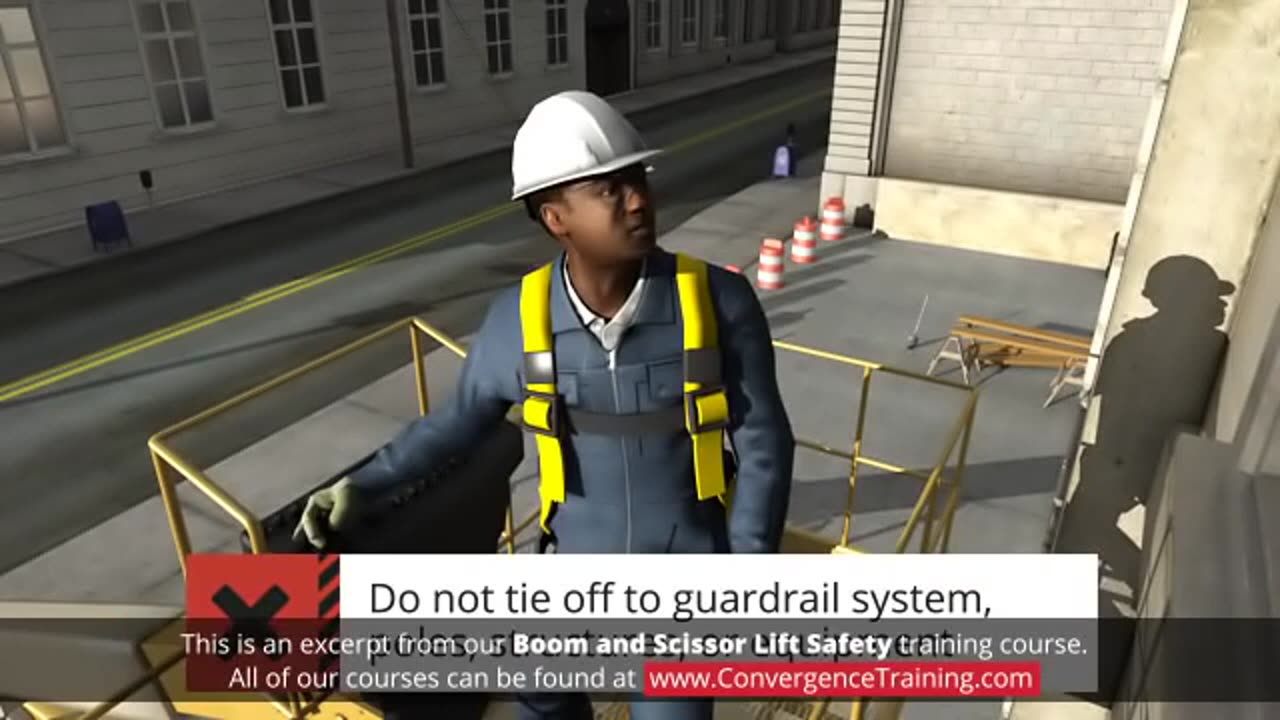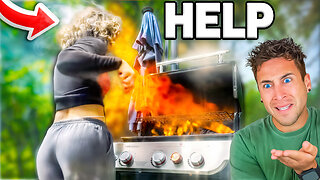Premium Only Content

Boom and Scissor Lift Safety for Canada
**Boom and Scissor Lift Safety** in Canada is an essential component of workplace health and safety, particularly for tasks involving work at height. Ensuring the safe operation of these aerial work platforms (AWPs) protects workers from falls, tip-overs, and equipment-related hazards. Here's a comprehensive overview of **Boom and Scissor Lift Safety** in Canada, including regulations, training, and best practices:
---
### **Key Regulations and Standards**
Boom and scissor lift safety is governed by federal and provincial/territorial occupational health and safety regulations, as well as specific industry standards.
#### **Federal Regulations**:
1. **Canada Labour Code, Part II**:
- Employers must provide a safe workplace, including protection against fall hazards.
2. **Canadian Occupational Health and Safety Regulations (COHSR)**:
- Specific provisions apply to federally regulated industries, including aerial lift equipment safety.
#### **Provincial/Territorial Regulations**:
Each province or territory has its own occupational health and safety laws. Common requirements include:
- Equipment inspection and maintenance.
- Worker training and certification for operating boom and scissor lifts.
- Fall protection requirements for working at heights.
#### **CSA Standards**:
1. **CSA B354.1, B354.2, and B354.4**:
- Cover design, safe use, and maintenance of aerial work platforms, including boom lifts and scissor lifts.
2. **CSA Z259**:
- Standards for fall protection equipment, which apply to workers using lifts.
---
### **Employer Responsibilities**
Employers in Canada must:
1. **Provide Proper Training**:
- Ensure all workers operating boom and scissor lifts are trained and certified.
- Training must include:
- Equipment operation and controls.
- Fall protection requirements.
- Hazard identification and emergency procedures.
2. **Conduct Risk Assessments**:
- Identify potential hazards, such as overhead obstructions, unstable ground, or weather conditions.
- Implement control measures to minimize risks.
3. **Inspect and Maintain Equipment**:
- Perform pre-use, periodic, and annual inspections as per manufacturer guidelines and CSA standards.
- Ensure maintenance records are up to date.
4. **Ensure Fall Protection Compliance**:
- Provide appropriate fall protection equipment (e.g., harnesses, lanyards) when required.
- Ensure anchor points meet CSA Z259 requirements.
5. **Develop Safe Work Procedures**:
- Include steps for operating equipment, working near edges or power lines, and handling emergencies.
---
### **Worker Responsibilities**
Workers using boom and scissor lifts must:
1. **Follow Training**:
- Operate lifts only if trained and certified.
- Adhere to safe work practices outlined by the employer.
2. **Inspect Equipment**:
- Perform pre-use inspections to identify any visible damage or malfunction.
3. **Use Fall Protection**:
- Wear a harness and lanyard when required, particularly in boom lifts.
- Anchor to designated points on the lift.
4. **Avoid Overloading**:
- Do not exceed the lift’s weight capacity, including tools and materials.
5. **Stay Alert**:
- Be aware of surroundings, including other workers, obstacles, and weather conditions.
---
### **Safe Operating Practices**
#### **1. Pre-Use Inspections**:
Workers must inspect:
- Platform and guardrails for damage.
- Controls and emergency stop functionality.
- Hydraulic systems for leaks.
- Tires, outriggers, or stabilizers for wear or improper deployment.
- Harness and lanyard condition (if required).
#### **2. Safe Setup**:
- Position the lift on stable, level ground. Use outrigger pads if needed.
- Set up barricades to prevent other workers or vehicles from entering the lift's operating area.
- Assess the environment for hazards like power lines, uneven ground, or high winds.
#### **3. Safe Operation**:
- Always operate lifts according to the manufacturer’s guidelines.
- Keep the platform level during operation.
- Avoid sudden movements, jerks, or overreaching while in the lift.
- Maintain a safe distance from power lines (minimum 3 meters or as specified by provincial/territorial regulations).
#### **4. Fall Protection**:
- Boom Lifts:
- Workers must wear a full-body harness with a lanyard attached to a designated anchor point.
- Scissor Lifts:
- Fall protection is generally not required unless specified by a risk assessment or local regulations. Workers must stay within the guardrails.
#### **5. Emergency Preparedness**:
- Ensure workers know how to use emergency controls.
- Have a rescue plan in place in case a worker becomes stranded or incapacitated.
---
### **Common Hazards and Mitigation**
#### **1. Tip-Overs**:
- **Hazard**: Unstable ground, overloading, or high winds.
- **Mitigation**:
- Use outriggers or stabilizers on soft ground.
- Do not exceed the lift’s capacity.
- Avoid using lifts in winds exceeding the manufacturer’s limits (typically 12.5 m/s or 28 mph).
#### **2. Falls from Heights**:
- **Hazard**: Workers leaning out or standing on guardrails.
- **Mitigation**:
- Always stay within the platform.
- Use fall protection as required.
#### **3. Electrocution**:
- **Hazard**: Contact with power lines or electrical equipment.
- **Mitigation**:
- Maintain safe distances from power lines.
- De-energize or insulate nearby electrical hazards.
#### **4. Crushing or Pinching**:
- **Hazard**: Workers or equipment getting caught between the lift and fixed objects.
- **Mitigation**:
- Keep a safe distance from walls, beams, or ceilings.
- Use spotters if visibility is limited.
---
### **Inspection and Maintenance Requirements**
#### **Inspection Types**:
1. **Pre-Use Inspection**:
- Conducted by the operator before each shift.
2. **Frequent Inspection**:
- Conducted monthly or after 150 hours of use.
3. **Annual Inspection**:
- Conducted by a qualified technician as per CSA B354 standards.
#### **Maintenance**:
- Follow manufacturer guidelines for lubrication, battery care, and part replacements.
- Keep a log of all maintenance and inspection activities.
---
### **Training and Certification**
#### **Training Requirements**:
- Employers must ensure workers are trained in:
- Safe operation of specific lift types.
- Fall protection equipment and procedures.
- Hazard identification and control measures.
#### **Certification Programs**:
- Many provinces require workers to complete a recognized training program (e.g., Working at Heights in Ontario or Fall Protection Training in Alberta).
#### **Refresher Training**:
- Workers should receive refresher training if:
- New equipment is introduced.
- Workplace hazards change.
- An incident occurs involving aerial lift equipment.
---
### **Conclusion**
Boom and scissor lift safety in Canada requires a collaborative approach between employers and workers to ensure compliance with CSA standards, provincial regulations, and best practices. Regular inspections, proper training, and adherence to fall protection requirements are critical to minimizing risks and maintaining a safe working environment.
-
 1:35
1:35
HSESafetyInformation
4 months agoMutton Chops two ways- baked & grilled Recipe by Food Fusion (Eid Recipe)
64 -
![ASMR Blind Box Opening! [FNAF, Crystals, Aphmau and More!]](https://1a-1791.com/video/fww1/45/s8/1/7/l/E/Y/7lEYy.0kob-small-ASMR-Blind-Box-Opening-FNAF.jpg) 26:45
26:45
Lacey Mae ASMR
11 hours agoASMR Blind Box Opening! [FNAF, Crystals, Aphmau and More!]
1.74K2 -
 9:25
9:25
MattMorseTV
17 hours ago $14.54 earnedMayorkas is in HOT WATER.
36.1K132 -
 3:49:08
3:49:08
Side Scrollers Podcast
1 day agoSTOP KILLING GAMES CRUSHES GOAL + OUR FINAL SHOW BEFORE SUMMER BREAK | Side Scrollers Live
46.4K4 -
 10:39
10:39
NikkoOrtiz
18 hours agoCooked TikTok Fails... Part 2
42.4K14 -
 17:02
17:02
GritsGG
16 hours agoBest Warzone Bundle Ever? Happy 4th of July!
25.6K3 -
 LIVE
LIVE
Lofi Girl
2 years agoSynthwave Radio 🌌 - beats to chill/game to
287 watching -
 23:30
23:30
The Pascal Show
18 hours ago $2.90 earned‘I FEAR FOR MY LIFE!’ Diddy’s Ex-Chef Speaks Out After Explosive Verdict!”
17.3K5 -
 5:45:57
5:45:57
MyronGainesX
18 hours ago $19.74 earned7/4 Merch Drop, Iran Checkmates US? HasanAbi Big Beautiful Bill MELTDOWN And More!
51.4K29 -
 6:17:39
6:17:39
SpartakusLIVE
13 hours ago#1 All-American HERO delivers JUSTICE and LIBERTY to the streets of Verdansk
68.7K2